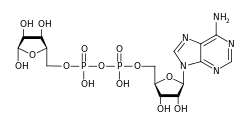
ADP-ribosylation
ADP-ribosylation is the addition of one or more ADP-ribose moieties to a protein. It is a reversible post-translational modification that is involved in many cellular processes, including cell signaling, DNA repair, gene regulation and apoptosis. Improper ADP-ribosylation has been implicated in some forms of cancer. It is also the basis for the toxicity of bacterial compounds such as cholera toxin, diphtheria toxin, and others.
History
The first suggestion of ADP-ribosylation surfaced during the early 1960s. At this time, Pierre Chambon and coworkers observed the incorporation of ATP into hen liver nuclei extract. After extensive studies on the acid insoluble fraction, several different research laboratories were able to identify ADP-ribose, derived from NAD+, as the incorporated group. Several years later, the enzymes responsible for this incorporation were identified and given the name poly (ADP-ribose) polymerase. Originally, this group was thought to be a linear sequence of ADP-ribose units covalently bonded through a ribose glycosidic bond. It was later reported that branching can occur every 20 to 30 ADP residues.
Podcasts:

